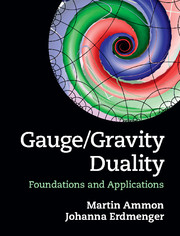Book contents
- Frontmatter
- Contents
- Preface
- Acknowledgements
- Part I Prerequisites
- Part II Gauge/Gravity Duality
- 5 The AdS/CFT correspondence
- 6 Tests of the AdS/CFT correspondence
- 7 Integrability and scattering amplitudes
- 8 Further examples of the AdS/CFT correspondence
- 9 Holographic renormalisation group flows
- 10 Duality with D-branes in supergravity
- 11 Finite temperature and density
- Part III Applications
- Appendix A Grassmann numbers
- Appendix B Lie algebras and superalgebras
- Appendix C Conventions
- Index
- References
6 - Tests of the AdS/CFT correspondence
from Part II - Gauge/Gravity Duality
Published online by Cambridge University Press: 05 May 2015
- Frontmatter
- Contents
- Preface
- Acknowledgements
- Part I Prerequisites
- Part II Gauge/Gravity Duality
- 5 The AdS/CFT correspondence
- 6 Tests of the AdS/CFT correspondence
- 7 Integrability and scattering amplitudes
- 8 Further examples of the AdS/CFT correspondence
- 9 Holographic renormalisation group flows
- 10 Duality with D-branes in supergravity
- 11 Finite temperature and density
- Part III Applications
- Appendix A Grassmann numbers
- Appendix B Lie algebras and superalgebras
- Appendix C Conventions
- Index
- References
Summary
In the preceding chapter we introduced the conjectured duality of N = 4 Super Yang–Mills theory and IIB string theory on AdS5 × S5 as a map between the open and closed string pictures of D3-branes. As we explained, a proof of this duality would require a full non-perturbative understanding of quantised string theory in a curved space background. This is absent at present. This means that, to date, it is not possible to give a proof of the AdS/CFT correspondence.
Nevertheless, some very non-trivial tests of the conjectured duality are possible, for which observables are calculated on both sides and perfect agreement is found. Some of these tests are presented in this chapter. Generally, tests of the correspondence are possible for both the strong form and the weak form as defined in table 5.1, both of which require the N → ∞ limit on the field theory side to ensure a classical calculation on the gravity side. While tests for the strong form with the 't Hooft coupling λ fixed but arbitrary will be discussed in chapter 7, in this chapter we focus on tests for the weak form for which λ is taken to be large. This amounts to calculations in classical supergravity on the gravity side.
An important issue is that in the weak form, the AdS/CFT correspondence maps a quantum field theory in the strongly coupled regime to a gravity theory in the weakly coupled regime. In part III of this book, we will use this property to make non-trivial predictions for strongly coupled field theories which cannot be obtained by standard quantum field theory methods. However, for the tests considered here, our aim is to compare observables calculated perturbatively at weak coupling within quantum field theory to the same QFT observables calculated at strong coupling using the AdS/CFT correspondence. This implies that only calculations for observables independent of the coupling may be compared directly to each other.
- Type
- Chapter
- Information
- Gauge/Gravity DualityFoundations and Applications, pp. 219 - 239Publisher: Cambridge University PressPrint publication year: 2015

